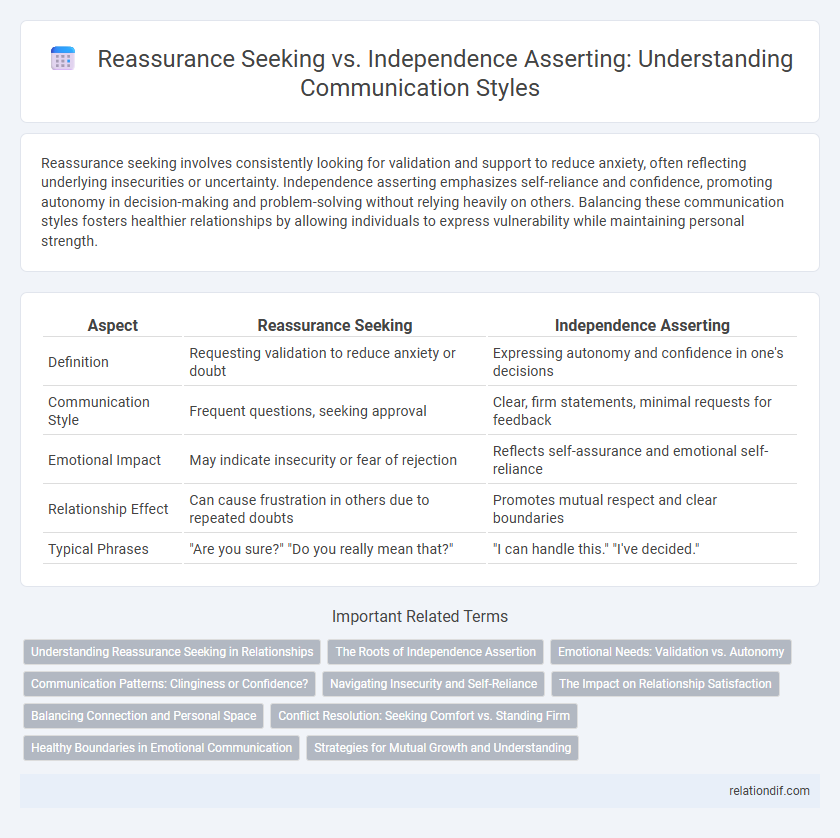Reassurance seeking involves consistently looking for validation and support to reduce anxiety, often reflecting underlying insecurities or uncertainty. Independence asserting emphasizes self-reliance and confidence, promoting autonomy in decision-making and problem-solving without relying heavily on others. Balancing these communication styles fosters healthier relationships by allowing individuals to express vulnerability while maintaining personal strength.
Table of Comparison
| Aspect | Reassurance Seeking | Independence Asserting |
|---|---|---|
| Definition | Requesting validation to reduce anxiety or doubt | Expressing autonomy and confidence in one's decisions |
| Communication Style | Frequent questions, seeking approval | Clear, firm statements, minimal requests for feedback |
| Emotional Impact | May indicate insecurity or fear of rejection | Reflects self-assurance and emotional self-reliance |
| Relationship Effect | Can cause frustration in others due to repeated doubts | Promotes mutual respect and clear boundaries |
| Typical Phrases | "Are you sure?" "Do you really mean that?" | "I can handle this." "I've decided." |
Understanding Reassurance Seeking in Relationships
Reassurance seeking in relationships often signals underlying insecurities and a desire for emotional validation, contrasting with independence asserting, which emphasizes self-reliance and confidence. Understanding the balance between these behaviors is crucial for effective communication, as excessive reassurance seeking can lead to dependence while promoting independence fosters personal growth and mutual respect. Recognizing the motivations behind reassurance seeking helps partners provide appropriate support without undermining autonomy.
The Roots of Independence Assertion
Independence assertion often stems from early developmental experiences where individuals learn to establish boundaries and self-reliance as a response to inconsistent or controlling communication environments. This behavior is rooted in the need to validate personal autonomy and reduce reliance on external validation, contrasting with reassurance seeking, which is driven by insecurity and the desire for approval. Understanding the psychological foundations of independence assertion aids in fostering communication strategies that promote self-confidence and healthy relational dynamics.
Emotional Needs: Validation vs. Autonomy
Reassurance seeking reflects a deep emotional need for validation, where individuals look for external confirmation to feel secure and understood. Independence asserting prioritizes autonomy, emphasizing self-reliance and personal boundaries as essential components of emotional well-being. Balancing these dynamics in communication enhances relationships by honoring both the desire for connection and the need for individual freedom.
Communication Patterns: Clinginess or Confidence?
Reassurance seeking often manifests as clinginess in communication patterns, characterized by frequent requests for validation and affirmation that signal underlying insecurity. Independence asserting reflects confidence through clear, direct messages that establish boundaries and promote self-reliance without needing external approval. Understanding these contrasting behaviors helps decode emotional needs and improves interpersonal dynamics by balancing support and autonomy.
Navigating Insecurity and Self-Reliance
Reassurance seeking often reflects underlying insecurity and can hinder self-confidence, while independence asserting promotes self-reliance and emotional resilience. Effective communication involves balancing the need for support with the development of personal autonomy to navigate insecurity constructively. Strengthening internal trust reduces reliance on external validation, fostering healthier interpersonal dynamics.
The Impact on Relationship Satisfaction
Reassurance seeking often signals anxiety and can lead to increased relational stress, undermining relationship satisfaction by fostering dependency. In contrast, independence asserting promotes personal autonomy and mutual respect, enhancing relationship stability and satisfaction. Balancing these behaviors maintains emotional security while supporting individual growth, crucial for long-term relational health.
Balancing Connection and Personal Space
Reassurance seeking involves actively requesting validation to strengthen emotional bonds, while independence asserting emphasizes maintaining personal boundaries and self-reliance. Balancing these communication strategies fosters healthy relationships by ensuring individuals feel both supported and respected. Effective communication navigates this balance, promoting trust and mutual understanding without compromising autonomy.
Conflict Resolution: Seeking Comfort vs. Standing Firm
Reassurance seeking in conflict resolution emphasizes emotional support and validation to alleviate anxiety and foster mutual understanding. Independence asserting focuses on maintaining personal boundaries and convictions, promoting self-confidence and clear communication of needs. Balancing the desire for comfort with the strength to stand firm enhances effective conflict management and relationship stability.
Healthy Boundaries in Emotional Communication
Reassurance seeking often stems from uncertainty and can lead to dependency, whereas independence asserting promotes self-confidence and personal growth in communication. Establishing healthy boundaries ensures emotional needs are met without over-reliance on others, fostering mutual respect and clarity. Effective emotional communication balances expressing vulnerability with maintaining autonomy, enhancing relational stability.
Strategies for Mutual Growth and Understanding
Reassurance seeking often arises from underlying anxiety and can create dependency patterns, while independence asserting emphasizes self-reliance and personal boundaries. Effective communication strategies include active listening, expressing needs clearly, and validating emotions without judgment to foster mutual respect. Embracing these approaches promotes balanced relationships where both partners grow and understand each other's perspectives.
Reassurance seeking vs Independence asserting Infographic

 relationdif.com
relationdif.com